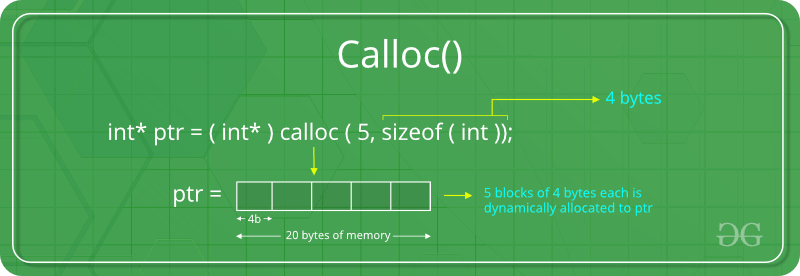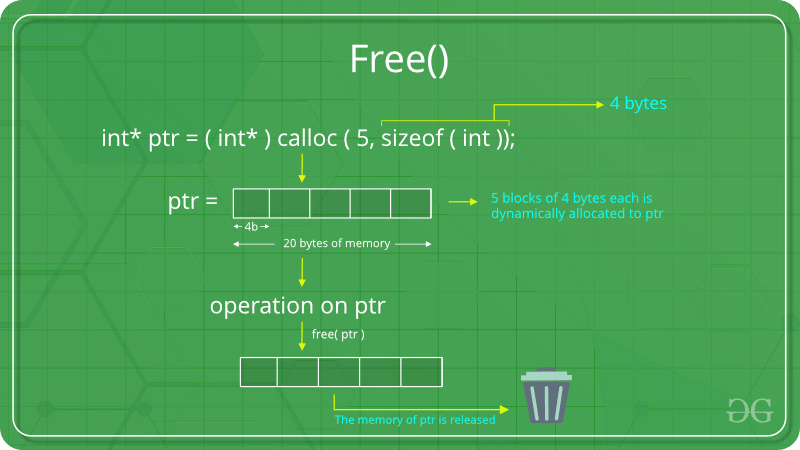
Since C is a structured language, it has some fixed rules for programming. One of them includes changing the size of an array. An array is a collection of items stored at contiguous memory locations.

As can be seen, the length (size) of the array above is 9. But what if there is a requirement to change this length (size)? For example,
This procedure is referred to as Dynamic Memory Allocation in C .
Therefore, C Dynamic Memory Allocation can be defined as a procedure in which the size of a data structure (like Array) is changed during the runtime.
C provides some functions to achieve these tasks. There are 4 library functions provided by C defined under header file to facilitate dynamic memory allocation in C programming. They are:
Let’s look at each of them in greater detail.
The “malloc” or “memory allocation” method in C is used to dynamically allocate a single large block of memory with the specified size. It returns a pointer of type void which can be cast into a pointer of any form. It doesn’t Initialize memory at execution time so that it has initialized each block with the default garbage value initially.
ptr = (cast-type*) malloc(byte-size)
For Example:
ptr = (int*) malloc(100 * sizeof(int));
Since the size of int is 4 bytes, this statement will allocate 400 bytes of memory. And, the pointer ptr holds the address of the first byte in the allocated memory.

If space is insufficient, allocation fails and returns a NULL pointer.
Output
Enter number of elements:7
Entered number of elements: 7
Memory successfully allocated using malloc.
The elements of the array are: 1, 2, 3, 4, 5, 6, 7,
ptr = (cast-type*)calloc(n, element-size);
here, n is the no. of elements and element-size is the size of each element.
For Example:
ptr = (float*) calloc(25, sizeof(float));
This statement allocates contiguous space in memory for 25 elements each with the size of the float.

If space is insufficient, allocation fails and returns a NULL pointer.
Enter number of elements: 5 Memory successfully allocated using calloc. The elements of the array are: 1, 2, 3, 4, 5,
“free” method in C is used to dynamically de-allocate the memory. The memory allocated using functions malloc() and calloc() is not de-allocated on their own. Hence the free() method is used, whenever the dynamic memory allocation takes place. It helps to reduce wastage of memory by freeing it.
free(ptr);

Enter number of elements: 5 Memory successfully allocated using malloc. Malloc Memory successfully freed. Memory successfully allocated using calloc. Calloc Memory successfully freed.
“realloc” or “re-allocation” method in C is used to dynamically change the memory allocation of a previously allocated memory. In other words, if the memory previously allocated with the help of malloc or calloc is insufficient, realloc can be used to dynamically re-allocate memory . re-allocation of memory maintains the already present value and new blocks will be initialized with the default garbage value.
ptr = realloc(ptr, newSize);
where ptr is reallocated with new size 'newSize'.

If space is insufficient, allocation fails and returns a NULL pointer.
Output
Enter number of elements: 5
Memory successfully allocated using calloc.
The elements of the array are: 1, 2, 3, 4, 5,
Enter the new size of the array: 10
Memory successfully re-allocated using realloc.
The elements of the array are: 1, 2, 3, 4, 5, 6, 7, 8, 9, 10,
One another example for realloc() method is:
Output